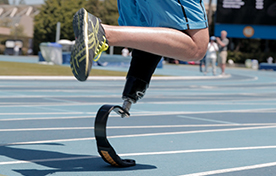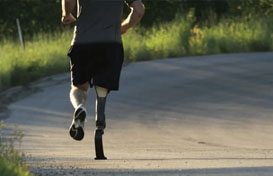Knee Disarticulation
– by Douglas G. Smith, MD, Amputee Coalition Medical

The knee disarticulation, also known as a through-knee amputation, has been with us for nearly two centuries. It was seen as a major surgical advancement at its inception, and it was! But in the nearly 200 years since it was first performed, the knee disarticulation has also become one of the most controversial amputation levels of all.
The first knee disarticulation in the United States was recorded in 1824. Since then, it has met with both favor and skepticism. It is one of those amputation levels that surgeons and prosthetists disagree about, and enthusiasm for it drifts in and out of favor like an awkward love-hate relationship. It is an amputation level that really illustrates the complexities in surgical decision-making.
Like the Syme ankle-level disarticulation (see inMotion, Volume 13, Issue 3), the knee disarticulation is an amputation done between bone surfaces, rather than by cutting through bone. In the 1800s, this was an important advantage. Mortality rates following knee and ankle disarticulations were lower than those for amputations in which bone was divided because there was less infection, bleeding and surgical shock. As healthcare and anesthesia have greatly improved, however, mortality rates for all amputations have declined and the risks of these dire complications are much lower than they were two centuries ago.
So why should anyone find fault with the knee disarticulation? Mainly, complaints have centered on prosthetic fit and the bulbous shape of the end of the residual limb. Dr. S. Perry Rogers was an orthopedic surgeon who, I’m told, also had a knee disarticulation from a war injury. Dr. Rogers wrote a research paper in 1940 in which he highlighted that opinion on the procedure was deeply divided, based on erroneous conclusions by some physicians and prosthetists. Noting that the Association of Artificial Limb Manufacturers of America had claimed that knee disarticulations were “impeding to successful prosthesis,” he objected, saying that this opinion was “no longer grounded in fact.” He also took issue with the argument that the bulbous end of the residual limb was a problem and provided photographic evidence that the bulbous shape “is useful in lifting the prosthesis and in controlling its rotation.”
More than 60 years have passed since Rogers presented that paper, and the controversy continues. When a particular procedure has both benefits and drawbacks compared with other procedures, there will always be differences of opinion.
Knee disarticulations are somewhat rare, accounting for only about 2 percent of major limb loss in North America.
Fortunately, for many individuals facing amputation near the knee joint, it is possible to perform a short transtibial (below-knee) amputation and leave the knee entirely intact. For other individuals, there is no choice but to amputate higher up in the thigh area. Still, though it is rarely performed, the knee disarticulation may well be the wisest choice for several distinct groups of people:
- For children, as an alternative to a thigh-level amputation, to preserve the growth plate at the end of the femur (thigh bone).
- For cancer or trauma patients when the tibia cannot be saved but the full femur remains intact and there’s good soft tissue for padding.
- For people who have problems with spasticity (erratic, uncontrolled motion) or contractures, which can result from spinal cord or brain injuries. Spasticity and severe contractures can leave the person with little or no knee mobility, and the knee often becomes fixed in a bent position. In these cases, the knee disarticulation can offer some unique advantages over either a transtibial or transfemoral (aboveknee) amputation.
Advantages of a Knee Disarticulation
In a knee disarticulation, the residual limb can generally tolerate some end weightbearing and provides a long mechanical lever that is controlled by strong muscles. The person retains a full-length femur, and the thigh muscles tend to be stronger because they are released at their distal (far) end, rather than transected at mid-muscle. Muscles that are cut at mid-thigh retract, become swollen, need more time to heal, and never quite regain all their strength. Farther down the leg, in the knee area, muscle blends into fascia (connecting tissue) and tendon. In a knee disarticulation, the surgeon does not cut through any muscle bellies. Instead, the surgical cuts are made in an area where the muscle blends into tendons, and these tendons hold surgical attachments far better than muscle does.
Knee disarticulations have particular advantages for children who are still growing because the growth plates at both the top and bottom of the femur are preserved. Most of the femur’s growth happens at the lower growth plate so the femur will not grow much more if the lower end of the bone is removed. If a young child has an amputation at mid-thigh, the residual limb will not keep pace in growth with the other limb. So, what may appear to be a long transfemoral amputation can turn out to be a short, troublesome residual limb by the time the person is an adult. If the child has a knee disarticulation, on the other hand, the femur will continue growing into adulthood. And, since the knee disarticulation occurs between bones, rather than by cutting through bone, it usually eliminates the childhood condition of painful bone overgrowth, which typically occurs after a bone is transected and new bone growth forms a spike or spur at the end of the amputation.
Intuitively, the knee disarticulation may seem functionally similar to a long transfemoral amputation. But several studies show that function with a knee disarticulation surpasses that of higher-level amputations and actually may be closer to that of a transtibial amputation when it comes to walking speed and ease of donning a prosthesis. However, additional research indicates that in cases of high-energy trauma, people with knee disarticulations may have some difficulties not seen as often with transtibial and transfemoral amputations. We’ll get to these studies and particular characteristics later.
“The current prosthetic technology has overcome all the objections.”
– Dr. S. Perry Rogers, surgeon and amputee, 1940
And the Disadvantages
On the minus side, while the patella (kneecap) can be retained, the two bones in the lower leg, the tibia and fibula, are completely removed. Unfortunately, the loss of the lower part of the knee joint essentially eliminates all knee power. While a person with a short transtibial amputation retains the entire knee joint and some of the tibia, providing much of the power needed to push up to go from sitting to standing, someone with a knee disarticulation no longer has that knee power. The person with a knee disarticulation, however, does have the benefit of the surface of half the joint to support weight. This, it is hoped, will make it possible to comfortably take weight directly on the end of the femur, which then allows for a lower profile socket that can provide greater comfort.
Like the Syme, the knee disarticulation often results in a residual limb with a bulbous end. Some people don’t like its appearance. And the bulbous shape of the limb also makes it a bit more challenging for a prosthetist to craft a prosthetic socket that fits it well. Prosthetists see individuals with knee disarticulations much less often than they do people with other lower-limb amputation levels. Because many prosthetists are not as experienced at creating sockets for people with knee disarticulations as they are for people with transtibial amputations, they have to work harder to achieve a good fit. Some prosthetists may even be reluctant to make one at all because they are less confident of a successful fitting. But, as Dr. Rogers noted, the bulbous nature of the residual limb makes the socket self-suspending. Once the limb is inside, usually it’s secure and the socket won’t fall off.
Another problem with appearance is that one thigh segment is longer than the other. The right and left don’t match anymore because several inches of extra length are needed on the amputated side for the distal padding, the socket, the connector and the prosthetic knee unit. When the person is sitting, the thigh section of the amputated leg is at least two inches longer than the other leg, and when he or she is standing, the joint center of the amputated leg is lower to the ground than the other knee is. In addition, the swinging action of the knees occurs at different levels. This looks as if it would be uncomfortable and cause major complications to the hips and back. While it seems obvious that this is a “big problem,” there’s actually little or no data to support this belief. As long as the prosthesis is designed so that the total length of both legs is equal and the hips remain level, the back can be straight, and for many there is no discomfort.
Some individuals with knee disarticulations do have problems, but the problems associated with a higher-level amputation may actually be worse. The lack of documented cases in the literature where problems are directly attributed to different levels of the knee centers is notable, and this absence may indicate that the number of back and hip problems related to the difference in knee centers is far less than assumed. In fact, there are no studies showing that individuals with knee disarticulations have higher rates of back or hip troubles than people with transfemoral amputations do. Back and hip troubles would appear to be an issue with both groups.
I’ve had patients tell me that a higher amputation revision was recommended simply on the basis of uneven knee levels, and that’s unfortunate because there is no data to prove that the difference in knee levels is detrimental. Advocates of this belief are basing their recommendation on hearsay and not evidence-based scientific study. If a knee disarticulation is revised, it must be shortened to a transfemoral amputation, which means additional issues and difficulties. The advantages of the knee disarticulation are lost when the amputation is revised up to the thigh level. When this happens, the person’s residual limb can no longer support much, if any, end weightbearing. Since the end can’t take much weight, the socket transfers weight to the side of the thigh and up onto the pelvis. The part of the pelvis that a person sits on is called the ischium. A transfemoral socket can be made so the ischium sits on it like a seat or so the socket goes around the ischium and contains it. Either way, the transfemoral socket usually pushes uncomfortably into the groin and buttocks, especially when the person is sitting. Unlike a transfemoral amputation, a knee disarticulation that’s comfortable and has good padding can tolerate weight on the very end of the residual limb, and then the pelvis is not needed as much for weightbearing.
Socket fit is important when a person is standing, of course, but many people don’t realize just how vital it is when a person is sitting. Since prosthetic devices are made for walking, we usually think about them for walking. However, we actually spend more time sitting than walking, and the socket must, therefore, also be comfortable when we are sitting. The top of the socket for a knee disarticulation prosthesis can often be made lower and softer than the socket for a transfemoral amputation. As a result, the proximal brim does not dig into the groin and the buttocks as much, and the socket can often be much more comfortable. Sometimes, this kind of socket is not initially used after knee disarticulation surgery because the area is still tender. However, about a year later, many people with a knee disarticulation can benefit from a much lower socket profile than if a transfemoral amputation had been done.
The most commonly used prosthetic knee unit for a knee disarticulation is called the 4-bar linkage knee. The 4-bar has four connectors, or pivots, working together and two bars on each side. Their alignment causes the knee center to move up higher on the prosthesis so that it’s easier for the person to keep the weightbearing line in front even when the knee is bent a little. The hinges work in concert to move the pivot point higher, making the unit more stable. This type of knee unit also improves the sitting appearance of the legs and lessens buckling of the knee when the person is standing.
The Kneecap
There’s no conclusive scientific evidence to say whether the kneecap should be removed or retained in a knee disarticulation. I’ve found through experience that there are times when it’s beneficial to preserve it. The quadriceps muscles in the thigh blend into a large tendon that contains the kneecap. The part of this tendon above the kneecap is called the quadriceps tendon, and the part of the tendon below the kneecap is called the patella tendon. But it is actually just a single tendon with a bone in its middle, not two separate tendons. This odd nomenclature was “etched in stone” centuries ago and remains with us today. The kneecap is a sesmoid, or a bone that forms inside tendons that curve around bones. This wonderful piece of natural engineering prevents the tendon from rubbing directly on the bone, which would cause the tendon to fray and tear. The bone exterior with cartilage provides a smooth gliding surface. And, by pushing the tendon away from the center of the knee joint, the tendon is stronger and has more of a mechanical advantage. Retaining the kneecap protects that tendon as it goes over the bone and helps with the attachment to keep the quadriceps strong.
If there’s a choice, I prefer saving the kneecap. I’ve had patients tell me, “I like moving my kneecap. It makes my knee feel better.” It seems to give them more of a comforting feeling, as well as a way to work the joint just a little bit. But if the kneecap is damaged by fracture, or if there’s a great deal of arthritis between the kneecap and thigh bone, it might be wiser to remove the kneecap. Though I believe there are some small, but real, benefits to retaining the kneecap if it is healthy, if there’s a bad fracture, cartilage damage or arthritis, addressing these problems becomes more important, and it may be worthwhile to remove the kneecap.
Function
Several studies have examined function following a knee disarticulation. Though some have shed interesting light on the different aspects of function, others have left us with more questions than answers.
A study titled Energy demands for walking in dysvascular amputees as related to the level of amputation (by M.S. Pinzur, J. Gold, D. Schwartz and N. Gross, published in the September 1992 issue of Orthopedics) looked at energy levels and self-selected walking velocity (the pace at which a person chooses to walk). The researchers looked at 25 people who had undergone amputation as a result of peripheral vascular disease (PVD) and five control patients of similar ages with PVD. Five of the study participants had mid-foot amputations, five had Syme ankle-level disarticulations, five had transtibial amputations, five had transfemoral amputations, and five had knee disarticulations. Each member of the five groups of people with limb loss and the five controls were measured for cardiac function and oxygen consumption while at rest, while at normal walking speed, and while at maximum walking speed. With the amputations higher up the leg, the researchers found that normal walking speed and cadence decreased, while oxygen consumption per meter walked increased. Also, the capacity to increase walking speed and oxygen consumption lessened. In other words, the higher the amputation level, the more effort needed to walk either short or great distances. A person with a transfemoral amputation uses more energy to walk than a person with a mid-foot amputation does. People with a knee disarticulation tend to have walking characteristics between those of people with transfemoral and transtibial amputation levels. The assumption might be that the function of those with a knee disarticulation would be closer to that of those with a long transfemoral amputation level, but, as this study shows, individuals with a knee disarticulation actually function closer to transtibial amputees than to transfemoral amputees. Why this is, we don’t know.
A study in Sweden, titled Function after through-knee compared with below-knee and above-knee amputation (by E. Hagberg, O.K. Berlin and P. Renstrom, published in the December 1992 issue of Prosthetics and Orthotics International), looked at how people rate the ease of getting their prosthesis on and off and how long they wear a prosthesis every day. The researchers questioned 59 individuals with limb loss – 24 with transtibial amputations, 17 with knee disarticulations and 18 with transfemoral amputations. Daily use of the prosthesis was reported by 96 percent of those with transtibial amputations, 76 percent of those with knee disarticulations and just half of those with transfemoral amputations. Only 4 percent of the transtibial respondents and 12 percent of the knee disarticulation participants reported having no use whatsoever for their prosthesis compared with 39 percent of the transfemoral participants. The study demonstrated that people with knee disarticulations function, in these areas, closer to the transtibial level than the transfemoral level. Donning the transfemoral prosthesis can be difficult, and this study also concluded that it’s easier to put on and take off the knee disarticulation prosthesis than the transfemoral prosthesis. The researchers concluded that “from a functional standpoint, TK (through-knee) amputation should be considered as the primary alternative to AK amputation when a BK amputation is not feasible.”
The Lower Extremity Assessment Project (LEAP), an eight-site study coordinated through Johns Hopkins University, examined about 169 lower-limb amputations resulting from high energy trauma, including 18 knee disarticulations. The results were presented at the Orthopedic Trauma Association 2002 and 2003 annual meetings, and the principal investigators were E. MacKenzie and M. Bosse. The primary outcome measurement tool was the Sickness Impact Profile (SIP), a questionnairebased outcome tool designed for health status research. Using the SIP, researchers were surprisingly unable to measure differences between the individuals with transtibial and transfemoral amputations. Interestingly, however, the study did show that those people with knee disarticulations from trauma had worse scores on the SIP than the other amputees. Also, by seven-year follow-up, at least five individuals had surgery to revise their knee disarticulation to the transfemoral level.
During a careful review, we found that almost all of the knee disarticulation surgeries involved tissue from the zone of injury. One theory is that these individuals did not have good, comfortable, scar-free padding that would allow the advantages of end weightbearing. I am one of many investigators involved in this multicenter project, and we have begun to recommend against doing the knee disarticulation in trauma when the soft tissue around the knee shows signifi- cant damage from the injury. This is consistent with the concept that the quality of soft tissue padding is more important than the length of bone. While the LEAP study suggests that in trauma cases, the knee disarticulation is less functional than transtibial or transfemoral amputations, this study has a small number of knee disarticulation subjects with a wide variety of injury patterns. This makes it difficult to reach a final conclusion, and, clearly, more study is needed.
“So if they had it all figured out in 1940, we must certainly have it figured out now. Right?”
– Dr. Doug Smith, orthopedic surgeon, 2003
It’s Better When It’s Better and It’s Not When It’s Not
While speaking in an educational setting or when performing telephone consultations, I’m sometimes asked whether I think a knee disarticulation would be preferable to a transfemoral amputation and if it should be done in a particular circumstance. That’s a tough question to answer because “it’s better when it’s better and it’s not when it’s not.” What a horribly accurate summary.
What I mean by that is if the amputation site heals without tenderness and is well-padded, there’s a very good chance that the person with a knee disarticulation will be better off than if a higher amputation level were chosen. But if the amputation site heals in a scarred and tender fashion, then it clearly would have been better to go to a higher level. The surgeon should form an opinion on the advisability of a knee disarticulation only after examining the zone of injury and the quality of tissues around the knee. The surgeon must then look into his or her crystal ball to see whether the leg will likely heal without pain. The quality of the soft tissue is the most important factor.
Decision-making in knee disarticulations really highlights the value of surgical experience and insight. Surgeons learn the technical ways to perform a procedure – where to cut, which muscles to use, and the anatomy of the nerves and vessels – and they also learn the range of indications for when a procedure may be appropriate. Only with experience, however, comes the knowledge of when it’s truly best to do it and when it’s best not to. Situations like those when scarring or insufficient padding would leave the area tender and uncomfortable are difficult to foresee but important to anticipate. While that knowledge is helpful, as much as we try, we cannot see into the future to know exactly how things will turn out. Sometimes, surgical outcomes are not perfect and some fine-tuning may be needed. We may realize after the initial amputation that a higher-level amputation is needed to try and lessen pain or to improve function. Initially, however, we must use our best judgment and make a decision without knowing what the ultimate outcome will be. We only really find out after the knee disarticulation heals whether the soft tissue can tolerate the end weightbearing pressure that leads to success. That’s why, unfortunately, I need to say, “It’s better when it’s better and it’s not when it’s not.”
Disclaimer: The following information is provided and owned by the Amputation Coalition of America and was previously published on the website http://www.amputee-coalition.org or the Coalitions Newsletter, inMotion.








